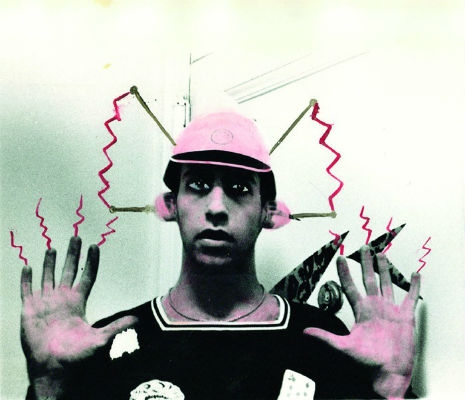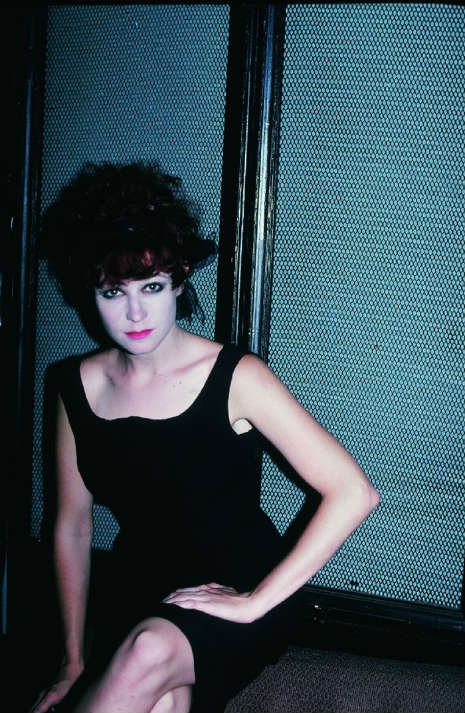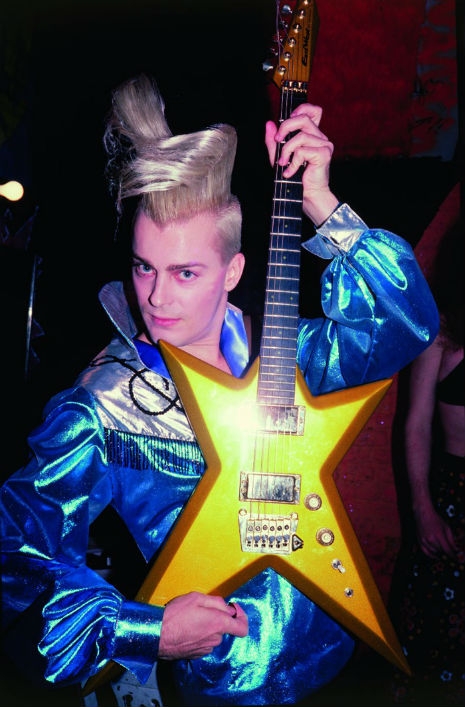
Photo of Kenny Scharf by Wendy Wild
During a high school theatre outing to New York in 1981, I managed to sneak away for a while to buy a few punk-rock records in the East Village. Walking down St. Mark’s Place, I saw a guy sporting the most outrageously high bleach-blond pompadour I’d ever seen. He was wearing a pink Teddy Boy suit and pink brothel creeper shoes. His companion was a busty blonde who looked like Dolly Parton, and dressed just like her, too. Even in the context of New York at that time, they were two groovy, glamorous celebrities from the future.
A few weeks later, I saw a photo of the flamboyantly dressed duo by Amy Arbus in the Village Voice, which must have been shot on the day that I saw them because they were wearing the same clothes. His name was John Sex and hers was Katy K. His profession was listed as “lounge singer/male stripper” and she was a fashion designer (Katy K did – and maybe still does – make stage clothes for Dolly Parton).
By the early 80s, the myth of Warhol and the sexy, druggy, doomed denizens who were his Factory’s superstars had spread pretty much everywhere, even to the remotest redneck corners of America (like my West Virginia hometown). For a certain type of kid, what they imagined Andy Warhol’s social life to be provided the impetus to move to New York City and reinvent themselves like the people in the photograph, who were associated with Club 57, a nightclub in the basement of a church where all the young art-school types hung out. They seemed like the second generation, drawn in by that Warhol myth but doing their own things.
East Village painters, musicians, performance artists, filmmakers, clothing designers and DJs had a second home at Club 57, run by Susan Hannaford, Tom Scully and performance artist Ann Magnuson, who was the manager, “den mother” and today the most emblematic person of that time and place. This trio provided an artsy/campy playground for the neighborhood misfits; Club 57 was a Fellini-esque salon for art shows, demented parties and elaborate DIY theme nights done on the cheap. The inspirations for the kooky neo-Dada Club 57 gestalt were things like The Sonny & Cher Show, kids TV shows, monster movies, 60s fashion, New Wave music and of course, Andy Warhol, its patron saint.
By the time I got to New York in 1984, Club 57 was gone, replaced by bigger clubs like Area and Danceteria, but the people who were a part of that scene still ruled New York nightlife. If you were at a party or art opening and people like Keith Haring, John Sex, Ann Magnuson, Joey Arias, Kenny Scharf, Fred Schneider and Jean-Michel Basquiat were there too, you knew you were in the right spot – they were the downtown royalty of the time. Within a few years, however, Hollywood had come calling for some and art-world fame and fortune for others. Then the ravages of AIDS truly ended the era.
Some 25 years later, museums are starting to catalogue and preserve the East Village 80s for posterity. A huge exhibition of paintings, photographs, sculptures, posters, party invitations, costumes and more, culled from the personal collections of Ann Magnuson, Kenny Scharf, Joey Arias, Howie Pyro and others – and curated jointly by Magnuson and Scharf – opened at the Royal/T gallery in Los Angeles in late 2011. Magnuson and Scharf are currently trying to figure out where the exhibition will travel next.
Richard Metzger: Nightlife scenes rarely form out of thin air; how did Club 57 come together?
Kenny Scharf: Keith Haring, John Sex (then known simply as John McLaughlin), Drew Straub and I were basically wandering the streets in the middle of the day, students at the School of Visual Arts. After having a 50¢ drink at the Holiday Cocktail Lounge, we went next door to Club 57 and saw a great jukebox, so we stayed. When the music began, Ann appeared from behind the bar – yes, a bar serving alcohol at a youth club under a church – and we all started wildly go-go dancing. Thus our immediate bond began!

Photo of Ann Magnuson at Club 57 by Robert Carrithers
Ann Magnuson: The core Club 57 crowd definitely cohered in the church basement, but many of us first met at CBGB and Max’s Kansas City. I met Susan Hannaford and Tom Scully the year I arrived in NYC – 1978 – and we formed an alliance that produced the New Wave Vaudeville Show together. That was the show where Klaus Sperber metamorphosed into Klaus Nomi. Almost everyone involved with the vaudeville show migrated over to Club 57. Kenny brought in his fellow SVA students like Keith Haring, Wendy Wild and John Sex. I knew Jean-Michel Basquiat already.
Kenny Scharf: Ann and Klaus Nomi came to my first show in 1979 at the Fiorucci boutique, and she asked me if I would like to show some art at Club 57. Soon after, I had a show called Celebration of the Space Age, where we served Tang and Space Food Sticks.
Ann Magnuson: Others were simply drawn in off the street by the posters for the Monster Movie Club. The original Misfits came in that way. The jukebox drew people in who liked to dance. Club 57 basically became a magnet for anyone interested in punk rock, obscure horror and exploitation films, 60s fashion and alternative neo-Dada theatre experiences. It was truly a neighbourhood hangout so anyone in the East Village who cared to could drift in and out. Some stayed longer than others.
Richard Metzger: Club 57 seems like it was running parallel to punk/New Wave in NYC, but not necessarily a part of it. How much overlap was there?
Ann Magnuson: Oh, Club 57 was definitely part of punk and New Wave. And everyone who went to Club 57 went to the Mudd Club too, or Max’s, or even Hurrah’s uptown.
Kenny Scharf: We all went to CBGBs and the Mudd Club, too, but Club 57 was really ours.
Richard Metzger: It seems like there was a lot of that Judy Garland/Mickey Rooney ‘Hey kids, let’s put on a show!’ spirit at Club 57. What are some of the ‘happenings’ that occurred there?
Ann Magnuson: We didn’t let anyone tell us ‘no’. We didn’t allow poverty to stop us from realising our wildest imaginings. One of my favorites was Putt-Putt Reggae, where we built a miniature golf-course out of boxes pulled from the trash and made it resemble a Jamaican shanty town, and the DJ played dub music. We had a hash-brownie-fuelled slumber party with go-go boys that the church father walked in on…
Kenny Scharf: It was terrible to leave town even for a few days for fear of missing something.
Ann Magnuson: Keith Haring curated the Erotic Art Show. There was a photo of a giant phallus at the entrance, and when I saw the church father coming towards us I had to head him off. It’s amazing we got away with what we did. In fact, a special neighbourhood meeting was called to complain about us. The neighbours asked Father John why he ‘allowed evil people in the church’ and he said, ‘That’s where evil people should be, in a church.’ God bless him!
Kenny Scharf: One night, I think it was Elvis night, we started a street brawl where I ended up hitting an off-duty cop on the head for punching a girl I knew in the face. It was dismissed because he was arrested on the court date for murdering his boyfriend.
Ann Magnuson: Another event was called Radio Free Europe, because I was obsessed with these communist fashion and lifestyle magazines I had found, and the neighbourhood was predominately Polish and Ukrainian anyway, so why not? I debuted my Russian pop star character Anoushka there (with her band Polska ’66). We gave (Russian accent) ‘free beet and potato at door’ to the members.
Read the rest with more images) at Dazed Digital. The interview appeared in print in the March issue of Dazed & Confused.

Photo of John Sex by Andee Whyland
Below, a clip from The Nomi Song documentary, where you see the debut of Klaus Nomi in The New Wave Vaudeville Show, as described above.